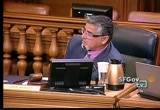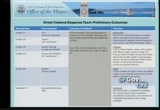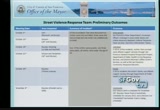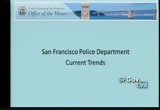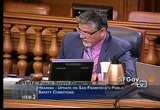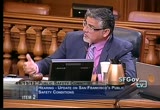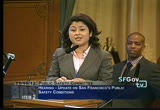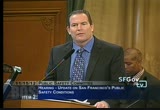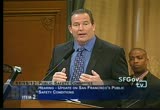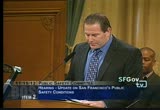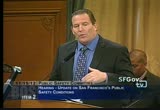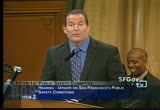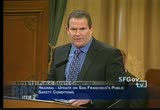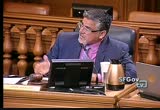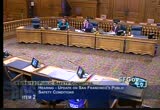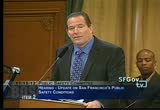tv [untitled] December 1, 2012 6:00pm-6:30pm PST
6:00 pm
by homicide? you personally? just trying to figure out the chain of command on that. >> jasmine dawson is in our office, if i know that family because of my previous work we try to work with that family but jasmine dawson is the contact person. we're actually encouraging that we keep these meetings overarching in terms of the planning piece for san francisco but then all the confidence one on one contact that it happen independent from this setting. because it is bound by confidentiality agreements. the service providers are the ones that know the families in depth and they are invited to our meetings to give information in
6:01 pm
a confidential way but also to link up to the rest of the constituents that are there. in terms of outcome, we are going to be tracking outcome and one big piece that's part of these meetings is organizing community events that really respond to some of the issues going on. currently right now with the 6 incidents that we have responded to, these are some of the outcomes that we have so far. these are the areas that were impacted in october through november up to date since i've been appointed to this position we've started these meetings and these are the homicides that have impacted san francisco, we've responded to all of them, the vrt teams have been able to be deployed and actually available to offer law enforcement in certain communities that need more patroling, more beat officers. that's part of our discussion as well because it's part of our full plan to prevent street violence. >> do you have hard copies of this? >> i do. i don't have any
6:02 pm
available but i can email. >> it's kind of hard to read on the screen. >> and in terms of the individual, again, like i mentioned earlier, san francisco's general office wrap around project is very instrumental there, they are a case management program that is at the bed site when a individual is critically wounded. they are a part of that prevention team that really tries to make sure that they understand the needs ftd individual and then work closely with any family members. as i mentioned earlier, dph is a part of this, all members that have been involved in this have been given the opportunity to engage in health services through dph the da works with the victims that need any type of victim services specifically whether they want to relocate or they need any type of assistance in general. then the crn works with the
6:03 pm
individuals impacted by street violence. they really try to target now deliberately anyone that is part of a homicide that might be gang involved or if there's further retaliation. now they are at the table really dialogues with sfpd, dph and all the cbo's to figure out how they can de-escalate the violence. in terms of exchanging information, of course in a confidential way, but there's definitely a more structured way to share information. i want to pause real quick and emfa zultz for the family piece, i would say that family, really really focusing on families as part of our treatment plans now because most often it's those fathers, it's the grandmothers, it's the girlfriends that really try to work closely with us and that actually contact the cbo's or offices to make sure their
6:04 pm
brother, sister, boyfriend that they actually get the wrap around service that is they need and what we find is that throughout all the scenarios that we have had, you know, the women that are part of these communities have been very vocal and have been one of those that really mobilize and organize their constituents and the voices of trying to promote peace. not trying to talk down to our male counterparts, that voice, but i want to emphasize what we've done so far we've seen a lot of women stepping up and being a part of that overall strategy and vision. >> we had a homicide in mount vern run in july, i'm not sure, i haven't had a chance to connect with the family yet but they actually, the mother who lost her son, has been holding vipblg i wills once a month on the date of the event every month since july.
6:05 pm
yeah, it's true, mothers are playing a large role. there's an organization called the healing circle which consists of men and women but a lot of leadership is women who are part of it then i, you know, it's really important work that women are doing and have met our part of it too. but again. >> thank you, the last part like i mentioned earlier, is the community piece so you know we're actually supporting the palsy event this afternoon, we're encouraging all the different peace events that happen in other xhuebts, we're encouraging that organization, working with the babies to try to create some kind of street fair to promote a message to try to decrease violence and offer resources. this again is a new component in terms of a violence prevention approach. it's about trying to break down all the individual service needs, really making sure that we wrap
6:06 pm
around families and that we look forward and try to create as much community dialogue. it's up and down, top and bottom, so there is no disconnect. hopefully in the future we will strive to create a better response to violence, a more coordinated violence. my hope is that we can deepk cease decrease some of these homicide attempts and hopefully just decrease violence. >> you did mention tonight we are having a community meeting at the libby rec center at 6:00 tonight. that's on the corner of montana and plymouth and that will be one of those community gatherings that we have had in the omi we have had a large number of homicides compared to other years. we shouldn't have any at all and it's a chance for community
6:07 pm
members to talk about what we're saying what needs to be done, investments in the neighborhood, so we can work together. there has been a lot of information, that strategy of working to the with the police department and other public safety departments and community-based organizations is really important. i think one thing that needs to be emphasized, we talk about the organizing aspect of the violence prevention work is really looking at the assets and what we need to build on in order to strengthen the efforts around. you mentioned wrap around projects, work force development education, i think those, the lack of those things is one of the root causes of violence and i think looking at not just getting paepl to work together but how we can make greater investments in these places so we can have more opportunity for people to find,
6:08 pm
or to get jobs or to get greater academic support in their lives. we were able to actually really impact more people that way, we know we're going to be laying the groundwork for real prevention that can stop this from happening in the future. so that's where i think it would be great if we can emphasize that more in future budget years. the children's fund is getting reauthorized but also there will be another grant cycle for the children's fund coming up that needs to really address these issues as well, especially in neighborhoods that have a higher incident of violence. that's an important direction to continue to go, we have to increase the investments we make and not just make sure people are working together, to identify what the needs are and how we can respond as a city. if we
6:09 pm
can make sure we are working to the and responding it that need i think we are making some progress that will play out for prevention moving forward. >> i'd like to add that for the mayor's office what we are doing is working closely to the budget office to be able to identify the resources needed according to the 3 layers i was referring to earlier. we need to target what kind of investment in order to make sure this plan is successful and make sure it's in a design or a program that ends up reaching the individuals that are mostly impacted, whether they are victims or perpetraters, of street violence. >> jobs are critical for the part of the citizens that are impacted by violence. up until this end there has not been any investment in work force placement dollars in district 11 and that was something that
6:10 pm
my office was able to get into the budget this year for the very first time. i think we need to look at where there is limited investment elsewhere in the city, including continuing to make greater investments in district 11 so we can see that impact. we are seeing a huge increase of public dollars. i think it's important to look at how we can use them and target in specific neighborhoods where we are seeing a high incidence of violence. >> thank you. >> good morning, supervisors, i'm john murphy, i'm the commander of investigations of the san francisco police department. without repeating what my learned colleagues have already talked about, i just want to say the overarching goal that chief sur has mandated, is no more fragmentation of responsibility for anyone. we as a city family, all the different agencies, have to share information and work
6:11 pm
together in order to solve the violence in our communities. because public safety is all of our responsibility. so without repeating what's already been said, i just want to talk about, you were asking about the new and more innovative things we are doing. we brought back many of the tried and true enforcement operations such as doing parole searches, probation searches, but we're now including other agencies. juvenile probation, the sheriff's department. how it's different is this. an individual might be on probation, he might be on parole, might be on juvenile probation or it might be abdomen paracs release. they may be in an area which is a violation of their probation but it may not necessarily be a crime. so by partnering with the juvenile adult probation we are able to identify people who are violating their probate and
6:12 pm
then the probation department can take action to that end. also assembly bill 109 has created a situation where we need to assess what's happening with post-release individuals. we're focusing on individuals that have been released from state prison that are on prcs that are arrested in possession of firearms. when they are arrested in possession of firearms, or if they are a victim of a crime, i get a copy of the report and i meet with wepbldy still or marty from adult probation and actually bring them a copy of the report. hey, this individual, not only are they on prcs release and they got arrested in san francisco, but they got arrested in oakland, they got arrested in richmond, they may have gotten arrested in san mateo. to that end it's all of our --
6:13 pm
the individual might have gotten arrested in san mateo, wendy will make sure we work together as a region as opposed to just san francisco. so there is no more fragmentation of responsibility. the other new thing we came up with is an actual calendar. you are familiar with zone enforcement. now we have an actual calendar for thursday through sunday and what it does, i personally do the calendar, i include the specialized units like the hondas, the solos, the tactical units, day watch and night watch and the violence reduction teams and gang task force. and the calendar, literally i assume people tote zones and assign people to those areas both days and nights and the supervisor who
6:14 pm
is on screen we have their cell phone number right on the calendar. so if something happens or if they need information from me, i can immediately send it to them. for example, just using it as an example, violence in the mission. what had happened was many of the officers, they have a general idea of location where the gang ipbs department "can you remembered, i was able to print out and send them the maps of the area and have the tack nick cal units, which are tactical units. you have it stay there, be very vigilant, let's see if this incident is going to escalate and while that's going on we find out whether it is even a gang-related incident. because we have had community based
6:15 pm
organization members who called me and said, hey, the one that happened at third, that's not a gang thing. it's a personal beef, you don't need to work about it. i think it's working, that the community-based workers are trusting us and reaching out to us to see what's going on. as far as technology we have ramped up our involvement with our technology in that we've created a base, a beta base, for people that have been arrested for robberies, people that have been arrested for guns. then we find out exactly where these robberies occurred then with that information the items that were taken a private data base called leads online and we see if that individual has been pawning property off prior so we're able to close those cases also and maybe solve prior violent crimes. to that end, i brought
6:16 pm
lieutenant plier to organize all the station sit teams and the sit teams are the station investigative teams where each team has, each station now has a stand-alone computer and a 55-inch screen where the crime alerts are streaming through. the officers are seeing what's going on in the city, who is wanted for what, whether they are known or unknown. so it's really incruised their awareness. then through that information sharing with the officers we're identifying individuals that have committed robberies and are unidentified and/or are involved in a series of robberies. the vrt team that we've talked about, the violence reduction teams, violence reduction team has about 45 people in it. so it's very effective to put them into the different zones under direct supervision and included in that is we reached out with
6:17 pm
a new program called the gun stop program. and a gun stop program basically is people can anonymously notify, call the police through the 553-1071, they call the doc and say that i know somebody that has a gun, they don't have to give their name, they don't have to say anything. they give us, they identify an individual and if an arrest is made, that individual is get a reward for turning that individual in and/or the gun. and it's all done through a private bank and the rewards vary but it's very effective and so far we've done real well anonymously seizing guns off people. >> how many? >> i think about 8. more than 8 this year.
6:18 pm
but what it does, remember, some of these people that the individuals are calling on, they are very violent people and they are afraid of them. so when they call, they are calling us, that's a key to us to say, wait a minute, if this person that knows this person is calling the police on this person that this must be a very serious issue. but it has worked where we've gotten, i believe, at least one ak 47, several semiautomatic handguns off people without talking about specifics that were just absolute key. then our meetings, we have meetings, standing meetings regarding cease fire. cease fire, we've had cease fire for several years but we tweaked it a little bit. and when i talked about the sheriff's department earlier, what the cease fire brings together is not only law enforcement but adult probation, juvenile probation, the sheriff's department. the sheriff's department has a classification unit, that classification unit, they have control over what happens in the jails.
6:19 pm
so although someone who is arrested on the street may not claim to be a gang member or they tell their probation officer they are not a gang member, when they go to the jail, if they are a gang member they do tell the classification unit and that's one way we can stop the violence in advance. that's one. two, we started streaming all of our crime alerts to the sheriff's department so who better to know the criminals than the individuals, the sheriffs, that watch the individuals and are with them and interact with them while they are doing time for prior crimes? or we have had instances, we have had an instance where the individual committed a series of crimes but they were arrested for the final crime and they are sitting in jail already. so it saves our resources, the police department working for this suspect when in fact he's already sitting in jail and the sheriff's department can tell us exactly where he's at. that's pretty much it, just in an overview of the i and the p part that we have started new.
6:20 pm
we still are doing, as i said, the probation searches, the parole searches, still doing a lot of the meetings but we tweaked them to make them a little better so we all are responsible. i brought some statistics for you today. first of all, the first slide depicts the homicides of all kinds city-wide this year compared to last year. as you can see, there is a spike in the bayview and the ingleside and in the southern. the ingleside case, an unfortunate case on house street, that resulted in 5 homicides. so it kind of skews the statistic that's there, that that's 14 homicides this year. >> i'm sorry, do you have -- i can't see, our screen is blinking and i don't have a hard copy. we've also seen a
6:21 pm
spike in the caravelle, the like view neighborhood and wondering if that's reflected on there as well. >> the spike, when you look at the empirical data, the spike on the numbers, actually the caravelle homicides are only up -- don't mean to say they are only up 1. >> up 1 from last year but for me a trend is something a few years in the making. what was it in 2010 and what was it in 2009 i think we'll see a trend upward that i have been concerned about. but certainly these numbers in the ingleside, visitacion valley and bayview are very high and compared to
6:22 pm
other years. i know that's a big concern for the department and the ipo strategy has come from that. since we started ipo and summer was very hot, how have we seen the homicides in terms of the trajectory we were on earlier this year, has it stayed the same? >> they have gone down. violent crime overall is down 3 percent this year or our non-fatal shootings are down 15 percent. i have another slide. this is a snapshot in time. last year we had a total of 50 homicides. we're more than that this year but when you look at that one isolated ipbs department really skewed our statistics for this year. i want to say also no homicide is a justifiable homicides, but just looking at the numbers, i have numbers over the years coming up, you will see how it's -- from our 2008 year
6:23 pm
where we had 98 homicides, we're still staying well below the average. >> i guess -- i mean i didn't ask the question well enough. this summer we had visitacion valley was very hot, like view was pretty hot, bayview was hot and it was a summer that the ipo strategy was discussed and was implemented, was launched. have we seen, what's the trend been like since the ipo strategy has come forward? >> take a look at the screen in front of you right now, the numbers, the homicides by month. we did notice the june and july spike where we had 18 homicides between the two months. but when we implemented the ipo plan, you'll see that part of the
6:24 pm
reason in the month of august we had no homicides at all, zero, and we haven't had that, when you look to the slide immediately to the right, historically that's an 11 year run from 2002 to 2011. august we averaged somewhere around 6 homicides. so if you look at the trend there, the trend clearly went down. yes, we did have a spike in june and july but then you see it's leveling off and even reduced september and october -- august way down, september and october had leveled off, november we have had two. so i think it's working. it's going to take us a little more time just looking at that one snapshot. >> supervisor olague. thank you. >> how does that compare to shootings. i know frequently there's an emphasis on homicides but it doesn't really speak to the fact that the violence is still occurring.
6:25 pm
you know what i mean, the shootings don't, just because a person doesn't --. >> you read our mind also. >> okay. >> one of the true gauges of violence is who actually gets shot and survived. so the next slide is our non-fatal shootings without homicides by firearms, just by firearms, in the police districts. this is city-wide. as you can see, the non-fatal shootings with firearms without the individual dying are down 15 percent. that's huge. you see the number of last year to date is 3 halloween was 152 and now we're down to 129. that's key to us. in fact, which you look at those shootings you are seeing the trend is going down and it has gone down. 2009, 2010, and here we are at 2012. >> thank you, it's good to
6:26 pm
note. and i do appreciate that. it's pretty clear in most police districts except for northern and northern we're seeing a trend upward. >> yes, we are. >> it's just important to note. >> it is important to note and in that light we have created a data base where we can track, when a shooting occurs we notice, we note where it takes place. so, for instance, if it took place in the 800 block of bue bucannon, the next likely place might be on march alley if i have the vrt south of market i will move them to the western addition, say, hey, we can't have a back and forth, a back and forth. we did have a back and forth during the summer where it looked like it was
6:27 pm
eddy block, kop, central diviz, i don't know who was warring with who but that accounts for the spike in numbers. >> supervisor olague. >> my whatever isn't working. but i was wondering is there every few years, i think it's every 10 years, they re-evaluate the election lines. will there ever be a vee-evaluation of the police --. >> boundaries? >> boundaries, yeah. there seems to be this, what's the word, northern station, they go to the marina and they have pieces of the western addition, there seems to be this kind of, i don't know, doesn't seem to be dramatic, i just wonder what criteria is used to create those boundaries and when was
6:28 pm
the last time it was evaluated. >> i think i've been in for 31 1/2 years, twice. the most recently was years ago. i got to think 20o25 years ago, at least 20 years ago, i think, but you're right, the definition of the western addition. >> the demographic shifted in the whole city to such an dmreepl it seems like there might be the time to start revisiting that. >> i see what you're saying. if you say the western addition, shouldn't that include 8th street? yeah. >> and nopale didn't exist. >> van ness has its own setting of issues. >> my neighborhood. then just a final slide that i have to present to you, it's
6:29 pm
the homicide by firearms and non-fatal shootings in the police districts. these are the people who, the non-fatal shootings, the people who survived and the people shot and killed. it's still down. we're still trending down 6 percent. i know those numbers aren't very comforting, for sure, we'd like to see them much lower, but i think our strategy is working. we are all strapped for staffing but i think we're doing a pretty good job of what we got. especially the calendaring of the personnel and our immediate response because if the supervisor working that day has any questions or if i need to talk to somebody directly, at least we can quell what's going on immediately by sending both uniform and plain clothes officers, motorcycle solo officers, the honda units. we can prestage them a
95 Views
IN COLLECTIONS
SFGTV: San Francisco Government Television Television Archive
Television Archive  Television Archive News Search Service
Television Archive News Search Service 
Uploaded by TV Archive on

 Live Music Archive
Live Music Archive Librivox Free Audio
Librivox Free Audio Metropolitan Museum
Metropolitan Museum Cleveland Museum of Art
Cleveland Museum of Art Internet Arcade
Internet Arcade Console Living Room
Console Living Room Books to Borrow
Books to Borrow Open Library
Open Library TV News
TV News Understanding 9/11
Understanding 9/11